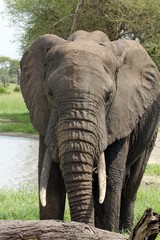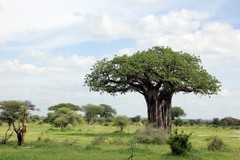Tarangire has to be one of My favourite Parks in Tanzania. Although we visited in the rainy season, which, according to the books is not so good for game viewing, we found it excellent and had no problems finding various interesting animals including Coke's hartebeeste, klipspringers and even fringe-eared oryx. It is the best park I've ever visited for seeing elephants, although it should be noted that many will migrate later on in the wet season.

Bull elephant in Tarangire
At this time of year thousands of elephants in family groups and batchelor herds are feeding on the long grass that covers much of the park. Many of the ungulates that prefer short grass have left with the onset of the rains either towards lake Manyara and further North or in to the Southern Maasai steppe, so don't expect to see zebras, wildebeeste or Thompson's gazelles, unless you are there in the dry season between July and November.
The soil in Tarangire has very low concentrations of phosphorus, an essential mineral for many lactating female animals, which causes many of the large ungulates to migrate to phosphorus-rich grazing areas outside the Park during the wet season.
The Park has some great scenery with rocky cliffs, hills, acacia savannah and woodland, combretum bush and swamps, and of course the beautiful Tarangire river, which flows all year. It is the best place to see baobabs in Northern Tanzania.
The river is fed by the huge Silale and Larmakau swamps in the Southern and Eastern parts of the Park which soak up enough water in the wet season to ensure flow throughout the year. The Silale swamp is readily accesible but to enter the far Southern parts of the park, which are pretty remote, you need a special permit and a Ranger as a guide. It's unlikely you'd want to go that far though, so it really doesn't affect the experience of visiting the Park.
Tarangire also benefits from low visitor numbers so once South of the main lodges in the North it is relatively easy to have huge areas of the Park to yourself, which greatly enhances the feeling of being in a true wilderness.

Baobab tree. For most of the year they are
leafless to combat drought
Tsetse flies can be a nuisance but they are generally only found in the areas of thick bush ie. combretums, and as soon as the vegetation opens out a little there are very few. Our strategy to beat them was to close all windows and the roof of the Landcruisier when entering one of these areas and drive through relatively quickly. It does get a little warm inside though, but we took it as the lesser of two evils.
Most of the camps don't have resident guides. Two or three nights can easily be spent here as there are so many different areas to see and even in the wet season we found plenty of game and birds.

The Tarangire river flows all year round
Special praise is given to the picnic sites, with spotlessly clean restrooms, great views, and some extremely audacious vervet monkeys that will not miss a chance to help you finish your lunch.
Threats - There are so many elephants in this park that they are converting the woodlands into savannah at an alarming rate. Elephants eat a lot and destroy much more than they eat and they can easily make a desert out of an area.
The expanding human population is putting increasing pressure on the wildlife migration corridors and dry season areas outside the National Parks. Five of the nine main wildlife migration routes are closed off, and the others are threatened by agricultural activity. Isolation of the park (and Lake Manyara with it) would lead to a severe decline in wildlife populations.
Watch the Tarangire video.